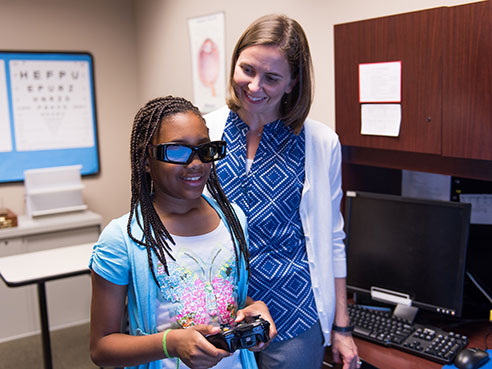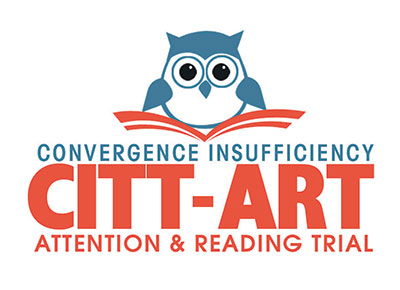 Kristine Hopkins and pediatric clinic patient. Photo by Nik Layman.Convergence insufficiency — the inability to keep both eyes working together — causes difficulties in the classroom for children and is often mistaken for attention deficit disorder due to an overlap in behaviors.
Kristine Hopkins and pediatric clinic patient. Photo by Nik Layman.Convergence insufficiency — the inability to keep both eyes working together — causes difficulties in the classroom for children and is often mistaken for attention deficit disorder due to an overlap in behaviors.
The University of Alabama at Birmingham School of Optometry is part of a multicenter clinical trial to determine what effects treatment of convergence insufficiency may have on reading comprehension and attention in these children.
UAB is one of eight centers taking part in the convergence insufficiency treatment trial (CITT) study funded by an $8 million five-year grant from the National Institutes of Health’s National Eye Institute.
“Children spend 75 percent of their school day reading and doing close work,” said Kristine Hopkins, O.D., MSPH, associate professor of optometry and site principal investigator. “A child with convergence insufficiency must use extra effort to keep the eyes working together to avoid double vision and blur, and this extra effort can cause symptoms like headaches and fatigue. It can also cause the child to read more slowly, be inattentive or avoid reading altogether.”
Hopkins says awareness of convergence insufficiency is key, as it often remains undiagnosed in kids because those affected may have 20/20 vision, and typical vision screenings rarely look at eye teaming skills.
“Children with untreated CI spend so much effort keeping the eyes working together that often simple reading assignments turn into hours of homework and frustrating battles with parents to get work done,” Hopkins said. “The child’s avoidance and difficulty completing reading assignments is similar to the behaviors of children with attention deficit disorder.”
 This is the second CITT study at UAB. The first showed that in-office vision therapy was effective for treating the signs and symptoms of convergence insufficiency in children.
This is the second CITT study at UAB. The first showed that in-office vision therapy was effective for treating the signs and symptoms of convergence insufficiency in children.
“While previous studies have shown that treatment of this condition improves eye muscle coordination and makes reading more comfortable for children, these studies were limited in scope,” Hopkins said. “This clinical trial will determine whether improved eye coordination will translate into improved reading skills and levels of attention for these children, and that’s why I’m so excited about this study.”
UAB and the other participating centers will be enrolling 324 children ages 9-14 who have signs and symptoms of convergence insufficiency. The children will be randomized to placebo or traditional office-based vision training, and outcome measures will include tests of reading and attention along with surveys to monitor what the teachers are seeing at school. Following treatment, assessments of reading and attention will be compared to baseline assessments.
“It’s amazing — we’re going to see whether things we do in the office every day translate into an improved quality of life for these children,” Hopkins said.
Children assigned to the placebo group will still be offered traditional therapy if needed once they complete the initial round of treatment. This means all children in the study will be offered treatment at no cost.
Enrollment in the study is ongoing and will continue through February 2017. For more information on this trial, visit citt-art.com.